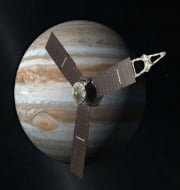NASA's Juno spacecraft successfully begins orbit of Jupiter
NASA’s Juno spacecraft has successfully entered into the orbit of Jupiter on 4th July 2016 and started orbiting solar system’s most massive planet.
The spacecraft was launched by NASA as part of its New Frontiers program in 2011 to study Jupiter’s composition, gravity field, magnetic field, and polar magnetosphere.
About Juno spacecraft
- The unmanned spacecraft has been named after the Roman goddess Juno, the wife of Jupiter who is considered as the god of the sky in ancient Greco-Roman mythology.
- Juno is the first mission designed by NASA to see beneath Jupiter’s clouds. It has travelled 2.7 billion kilometres since its launch to reach Jupiter.
- The mission previously was been referred to by the backronym JUpiter Near-polar Orbiter.
- Orbit: It will orbit Jupiter from pole to pole, 5,000 kilometres above planet’s cloud tops.
- It will sample Jupiter’s charged particles and magnetic fields for the first time to study its composition beneath the sky.
- Payloads: Juno has nine instruments on board to study atmosphere, gravity, magnetic field and possible existence of solid core in Jupiter.
- Juno will map Jupiter’s gravity and magnetic fields and also track how much water is present in the atmosphere.
- Mission Life: Juno will have mission life of 20 months from July 2016 to Feb 2018. In its mission life, the spacecraft will circle the Jupiter 37 times before finally making a death plunge in 2018 in order to avoid accidentally crashing onto one of the planet’s moons.
Special Note: Juno is not the first spacecraft to orbit Jupiter. It is second spacecraft to orbit Jupiter, after Galileo probe which had orbited the planet from 1995–2003. Galileo probe in its mission had found evidence of subsurface saltwater on Jupiter’s moons Europa, Ganymede and Callisto.
Facts about Jupiter
- Jupiter is solar system’s most massive planet and is fifth from the sun after Mercury, Venus, Earth and Mars.
- It is known for its Great Red Spot because of a storm (bigger than size of Earth) that has been raging for hundreds of years.
- Diameter: 142000km (11times size of earth)
- Composition: Hydrogen (90%) and Helium (10%).
- Known moons:
- Length of day: 10 hours.
- Average temperature: -145 degree Celsius.
- Volume: 1329 Earths could fit inside Jupiter.
Month: Current Affairs - July, 2016
No Comments
Leave a Reply
You must be logged in to post a comment.



vinoth suganth
July 5, 2016 at 8:12 pmJuno was launched from Cape Canaveral Air Force Station on August 5, 2011 and arrived on July 5, 2016.
vinoth suganth
July 5, 2016 at 8:12 pmJuno was launched from Cape Canaveral Air Force Station on August 5, 2011 and arrived on July 5, 2016.